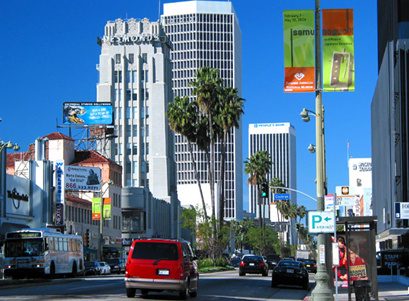Miracle Mile, Los Angeles
USINFO | 2013-05-21 09:28

The Miracle Mile in Los Angeles, California, is an area in the Mid-Wilshire district and partially in the Mid-City West subregion consisting of a 1.5-mile (2.4 km) stretch of Wilshire Boulevard between Fairfax and Highland Avenues. It may also refer to the surrounding neighborhoods (including Park La Brea).
The Miracle Mile District is bordered by the Fairfax District on the north, Hancock Park on the northeast, Mid-City on the southeast, West Los Angeles on the south, and Carthay Circle, Carthay Square and South Carthay on the southwest. The district's boundaries are roughly 3rd Street on the north, Highland Avenue on the east, San Vicente Boulevard on the south, and Fairfax Avenue on the west. Major thoroughfares include Wilshire and Olympic Boulevards, La Brea and Fairfax Avenues, and 6th Street.
In the early 1920s, Wilshire Boulevard west of Western Avenue was an unpaved farm road, extending through dairy farms and bean fields. Later it was integrated into the Pacific Electric Railroad System--a large network of trolley cars known as Red Cars. This transit system included a Wilshire Boulevard line through the post-WWII era. Parallel lines ran on Santa Monica Boulevard, Olympic Boulevard, and San Vicente Boulevard. They were connected by north-south lines on Fairfax and Highland Avenues.
Developer A. W. Ross saw potential for the area and developed Wilshire as a commercial district to rival downtown Los Angeles. A historical context preceding the development of the Miracle was the displacement of the Los Angeles Jewish community by restrictive rental and ownership opportunities in downtown and prestigious neighborhoods as a result of nativist anti-Semitism brought with the large influx of mid-Westerners to Southern California. The Miracle Mile development was initially anchored by a Jewish owned May Company Department Store on the west and the E. Clem Wilson Building, then the Los Angeles' tallest commercial building having a dirigible mast on top, home to a number of Jewish businesses and professionals relocating from a downtown and served as an impetus for the migration and growth of the Jewish community in the Fairfax vicinity. The success of the new alternative commercial and shopping district outside of downtown negatively effected downtown real estate values and began the multiple downtowns which characterizes contemporary Los Angeles.
The Miracle Mile District is one of the city's more densely populated areas, but is considerably more affluent than other high-density neighborhoods like Westlake and Koreatown. As a result, traffic congestion in the district is high even by the standards of Los Angeles.
To alleviate problems and provide an alternative to automobiles for commuters, proposals have been made to extend Los Angeles Metro's Purple Line subway to Fairfax Avenue or points further west, from its current terminus at Western Avenue in Koreatown.
Share this page